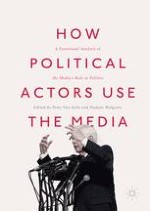2017 | OriginalPaper | Buchkapitel
8. When Politicians React to the Media: How the Attitudes and Goals of Political Elites Moderate the Effect of the Media on the Political Agenda
verfasst von : Alon Zoizner, Yair Fogel-Dror, Tamir Sheafer
Erschienen in: How Political Actors Use the Media
Aktivieren Sie unsere intelligente Suche, um passende Fachinhalte oder Patente zu finden.
Wählen Sie Textabschnitte aus um mit Künstlicher Intelligenz passenden Patente zu finden. powered by
Markieren Sie Textabschnitte, um KI-gestützt weitere passende Inhalte zu finden. powered by
